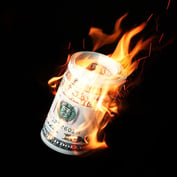Apple is probably the most-watched stock in America, so it’s no surprise that it also attracts more than its share of rumors. The latest is that the electronics behemoth is ready to split its stock, a story that started circulating last week and with enough force to move the stock upward for a brief while.
One thing that made the story noteworthy is that stock splits have basically gone the way of the dodo. According to data compiled by S&P Dow Jones Indices, in the 1990s, there was an average of 64 stocks every year declaring a split. That has turned completely around since the stock market crash. Altogether, since the economic crisis began back in 2008, the number of stocks declaring a split has dwindled all the way down to 10 per year.
Companies no longer seem to mind if their share prices get out of hand. Although Apple has been down in recent months, it’s still trading at well over $400. Google’s share price is even more unwieldy, at about $830, even though its market cap is only two-thirds of Apple’s. And of course, the granddaddy of the lofty share price is Warren Buffett’s Berkshire Hathaway, at more than $150,000. In addition to those three, there are three other stocks in the Standard & Poor’s 500 priced at more than $400: Intuitive Surgical, Mastercard and Priceline.com.
But should investors care whether those stocks split? Do stock splits have any tangible effect on the markets, aside from making share prices look a little more palatable?
For the most part, the effects are cosmetic. But that’s all the more reason to be aware of them and not get suckered in to making decisions you wouldn’t otherwise make. The primary reason for stock splits in the history of the American markets, after all, was to make stocks appear more attractive to the individual investor. A $20 stock doesn’t just seem to be more affordable than a $200 stock — it also appears to have a lot more room for appreciation.
The recent paucity of stock splits has resulted in stock prices appearing to be much higher than they might otherwise be. The average share price of a stock on the S&P 500 has risen from $31.36 in 2008 to more than $63 now. That’s almost exactly a 100 percent gain, only 67 percent of which can be attributed to the increase in the overall value of the index in that time.
The lack of stock splits has also caused trading volume to appear lower than it otherwise would. An institutional trader buying $1 million worth of Apple stock, for example, would be buying 2,353 shares at its current price of around $425. A two-for-one split would mean the same investor making the same investment was now buying more than 4,700 shares. The investment data company FactSet has reported, for instance, that Berkshire Hathaway, with its massive share price, has had just 534 shares change hands, on average, for each of the past 30 days. (A stock like IBM, by contrast, has a trading volume of more than 3 million shares a day.)








 March 07, 2013 at 12:25 PM
March 07, 2013 at 12:25 PM










